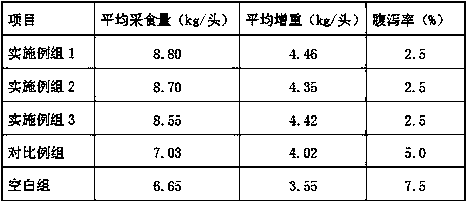A method for treating mink, raccoon and fox carcasses by enzymatic hydrolysis
An enzymatic hydrolysis method and a technology for carcass, applied in the field of enzymatic hydrolysis treatment of carcasses, can solve the problem of no treatment method, and achieve the effects of reducing processing cost, high efficiency and regulating nervous system.
- Summary
- Abstract
- Description
- Claims
- Application Information
AI Technical Summary
Problems solved by technology
Method used
Image
Examples
Embodiment 1
[0026] (1) Take 1000g of frozen mink carcass, separate the viscera and carcass after thawing, clean them, mix them with a meat grinder and grind them, transfer them to an enzymatic hydrolysis tank, add 1100g of water, cook for 20 minutes until fully cooked, adjust the temperature to 50°C, and pH to 7.5 , add neutral protease 1.2g, trypsin 1.5g, telopeptidase 0.3g, enzymolysis for 4 hours.
[0027] (2) Take Houttuynia cordata, Sophora flavescens, astragalus, and sweet-scented osmanthus at a mass ratio of 1:1:1:3, add water 5 times the total mass of traditional Chinese medicine after crushing, add the total amount of traditional Chinese medicine at PH: 5.5, temperature: 50°C 0.2% cellulase, enzymatic extraction for 2 hours.
[0028] (3) Take the mass ratio of the enzymatic solution in step (1) and step (2) to be 20:1, mix well, add calcium citrate, the amount added is 0.1% of the mass of the mixed enzyme solution.
[0029] (4) Heat up to 80°C, keep for 20 minutes to inactivate ...
Embodiment 2
[0031] (1) Take 2 tons of fresh fox carcasses, separate the liver and carcass, clean them, mix them with a meat grinder, grind them, then transfer them to an enzymatic hydrolysis tank, add 2.2 tons of water, cook them for 20 minutes, and adjust the temperature to 50°C. PH=7.5, add papain 1.0kg, neutral protease 5.0kg, trypsin 3.5kg, telopeptidase 0.5kg, enzymatic hydrolysis for 5 hours.
[0032] (2) Take Houttuynia cordata, Sophora flavescens, astragalus, and sweet-scented osmanthus at a mass ratio of 1:1:1:2, add water 5 times the total mass of traditional Chinese medicine after crushing, add the total mass of traditional Chinese medicine at PH: 6, temperature: 50°C 0.15% cellulase, enzymatic hydrolysis and extraction for 1.5 hours.
[0033] (3) Take the mass ratio of the enzymatic solution in step (1) and step (2) to be 20:1, mix well, add calcium gluconate, the amount added is 0.05% of the mass of the mixed enzyme solution.
[0034] (4) Heat up to 80°C, keep for 20 minutes...
Embodiment 3
[0036] (1) Take 50kg of fresh raccoon meat, separate the liver and carcass, clean it, mix it into a meat grinder, grind it and move it into an enzymatic hydrolysis tank, add 55kg of water, cook it for 20 minutes until fully cooked, adjust the temperature to 50°C, PH=7.5 , add papain 20g, neutral protease 100g, trypsin 60g, telopeptidase 20g, enzymatic hydrolysis for 3 hours.
[0037] (2) Take Houttuynia cordata, Sophora flavescens, astragalus, and sweet-scented osmanthus at a mass ratio of 1:1:1:2, add water 5 times the total mass of traditional Chinese medicine after crushing, add the total mass of traditional Chinese medicine at PH: 5.5, temperature: 50°C 0.15% cellulase, enzymatic hydrolysis for 2 hours.
[0038] (3) Take the mass ratio of the enzymatic solution in step (1) and step (2) as 20:1, mix well, add calcium citrate, the amount added is 0.05% of the mass of the mixed enzyme solution.
[0039] (4) Heat up to 80°C, keep for 20 minutes to inactivate the enzyme, cool ...
PUM
 Login to View More
Login to View More Abstract
Description
Claims
Application Information
 Login to View More
Login to View More - R&D
- Intellectual Property
- Life Sciences
- Materials
- Tech Scout
- Unparalleled Data Quality
- Higher Quality Content
- 60% Fewer Hallucinations
Browse by: Latest US Patents, China's latest patents, Technical Efficacy Thesaurus, Application Domain, Technology Topic, Popular Technical Reports.
© 2025 PatSnap. All rights reserved.Legal|Privacy policy|Modern Slavery Act Transparency Statement|Sitemap|About US| Contact US: help@patsnap.com


